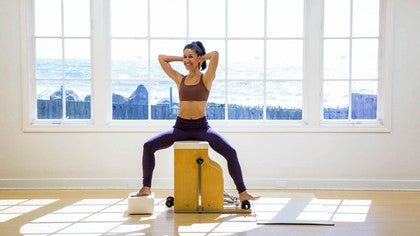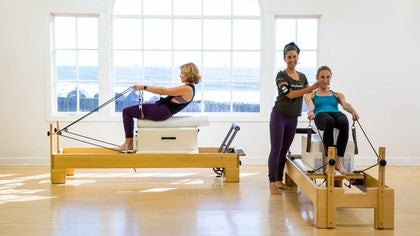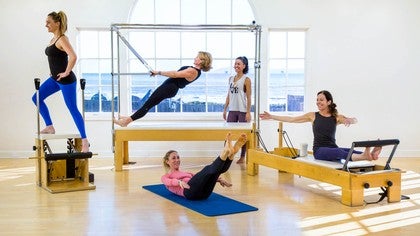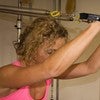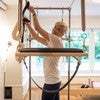Description
Note: This class is great for teachers who are interested in introducing the apparatus in a group setting. Because many of the exercises are more advanced, it is recommended for advanced practitioners.
About This Video
Transcript
Read Full Transcript
Okay. Hi, thanks for joining us today. So we're doing a circuit class. Um, and so what we're gonna do is have each person at a station doing a different exercise at the same time for more or less four minutes at a station. And then we're all gonna switch and move onto the next station. So, um, before we do this though, I'm going to break down what exercise is going to happen at each one of the stations for the first round. And then we'll pause and we'll do that again for the second round.
So it'll be a total of eight exercises, um, to on the trapeze table, two on the reformer, two on the mat and two on the chair. Okay. And this is, um, a higher level class. The assumption is that, um, we're not new to Palazzos, we're not novice movers. And also that the instruction, the instructor is not new to teaching, um, that you feel really confident and really comfortable with all of these exercises and um, and yeah, and it's a great way to introduce apparatus in a group setting. All right, so here we go. So we're going to set up first for push through, um, and pelvic press. So one's going to flow into the other. So we start in this long sit position and we'll just let the shoulders relax and you'll start to hinge back at your pelvis, keeping that long line through your spine. So keep your chest up with, yeah, I want to lift your head up. So before we're pushing anywhere, just kinda hang off the bar. Find that place where it's easy, where the shoulders can relax, where you feel, um, kind of like your waterskiing maybe. And now from here, as you exhale, you'll start to press and move into a chest lift position where you're flexing through your upper back, moving the bar through and just being mindful of always holding onto the bar here. And then you'll take an inhale here, and as you exhale, again, remember to relax your shoulders and start to curl back from your pelvis. Imagine that you want your arms to keep pushing the bar towards me as your pubic bone curls back. So you give yourself that sense of opposition and then we bring it back up.
And I'm, while I'm here, I'll make it feel good for her. So we're in a push up and you can kind of hang from the bar a little bit and let your shoulders widen. So now again, imagine you want your head and neck and shoulders to stay where they are as your pelvis starts to curl back. Really want to see that lumbar spine moving back as your feet. Push the pedals or rather push the risers away and then again curling through. And we'll just do that one more time. So again, as if the bar, we're going to stay where it is.
Allow your sitting bones to move through to your feet. Unwind the spine. Find that place where you're just kind of hanging off of the where you're back here and it feels easy and you can elongate your spine. Hold it here for a second and just let your upper back relax a little bit. There we go.
So finding that place where you've got freedom to move in all directions. Before we start going back up one more time and reaching through. And now again as if your head, neck, and shoulders, we're going to stay where they are. Initiate from your pelvis, curling back, shoulders roll back and wide. Lift your head. So again, hang. So there's no effort here. We're just kind of getting some space through the shoulder, through the armpit.
Now this time you'll stay here. So they're going to come back. Stay here. Start Bending your knees and curling again through the pelvis to slide under the bar into pelvic press. So from here we bridge up and push through the feet. Keep the Chin in. So we want to keep that feeling of um, as if we were just standing. So finding that long diagonal line while we're here.
And now lift your pelvis as you bend your knees, really keeping that hip extension as you come back down onto the space between your shoulder blades and rolling back down. And now again, push through your feet as you lift through your head to curl up to sitting. So coming back up to sitting tall, we're again, we're just kind of hanging off of the bar. So the whole theme here is looking at the relationship between the feet, pushing the pelvis through space and the pelvis informing the movement through the spine. So let's try that one more time. We're going to bend the knees, curl through the pelvis to slide under him, pause, and then again start to curl back up into bridge. Feeling really long. You push through your feet, keep the chin. And so really important as we're lifting up that we're keeping that sense of the crown staying in line with the tailbone. And then again, when we bend the knees, we keep the pelvis up careful with the neck.
So you want to come down into the shoulders, roll back down and release. One more time. Coming all the way back up. Let's just do that one last time. So again, bend and curl under. Pause here for a second. Curling up through the bridge. Slowly. Hold it here for a second. So stay on the space between your shoulder blades. Yeah, find that place where you feel very comfortable.
Notice the relationship here between the ears, the shoulders and the hips. Try and keep it about the same as you're pushing through your feet to come up so that there's, yes, very good. A little more keeping things connected and now again, very mindfully keeping the hips extended cause round two we've got the parakeet. So this is the key for a successful parakeet is that feeling of keeping the pelvis up. Awesome. Very good and rest. Thank you. Any questions from anyone about that first one? Okay, so that's going to be stationed one.
Now we're going to come over for stomach massage
Keep looking down, keep the whole curve throughout the whole spine. Now stay here and you're going to bring your hands behind you. And this time you'll push either shoulder blocks and if the shoulder blocks don't feel comfortable, you can put your hands on the mat with little tripod fingertips. Um, if you have the length through your arms enough to have the heel of the hand on the mat, that's fine. But now again here, really think about the shoulders rolling back the chest Stang up. And again, we're going to press all the way out and heels come under flex and point and back in. We'll just do that one more time, but when we go through the actual circuit, we'll do it three and do three or four of each. Now you'll pause here, start to reach the arms out in front of you and imagine you really want to lift your ribs up off of your pelvis as you're pressing back out, keeping that sense of tall spine flex
Oregon's beautiful. On this next one, as you press out, we're going to turn coming into rotation and really noticing how you're rotating at your ribs. Bend your knees and come back as you turn to the bar and then coming around the other way. Beautiful. Let's just do one more on each side. Keep thinking of lifting really tall as your pelvis is rooting down. Last one
All right, very good. Any questions? Any? That's good. Okay, so now we'll come over to Juliana and we're going to look at assisted roll up here. So go ahead and bring your knees into your chest and you'll hold onto the back of your thighs. And this one is all about using your own body weight and the timing of the movement to make it feel really easy. So we'll start to push the feet away as we lift up into a chest lift position.
And imagine your feet are going to go out and through the other end of the room coming all the way up to sitting tall and now keep your feet on the ground as you curl back. So again, it feels like the bridge in the sense that we're articulating from the pelvis down and then it's the roll up articulating from the crown of the head. Yes, using the legs as the lever. That helps. Awesome. So we'll do like four of those when we're going through the circuit. And then the next time that you've come up this way, we're going to link this up with single leg stretch and we'll start it from a seated position. So you'll put your right hand on your left knee and your left hand on your left Shin and you're going to lengthen your right leg all the way out. And so you'll start to roll back like you just did in that assisted, um, roll up position. Carry this leg with you, but your Shin is pushing up to help keep you up in that chest lift position.
And then we'll switch and switch. Keep pushing the leg away from you as it comes in so that your arms have something to pull back against. Keep thinking your Shin wants to move towards the ceiling. Awesome. And last one, and then we'll rest. Let your head come back down. Inhale. And now again, as you exhale, curl up into the hundreds position and use your legs to help get you there at first.
And you'll reach the arms out in long and we'll start pumping your arms and exhale. It's not her first hundred right? It's nobody's first hundred in this kind of a class. So you'll do your own counting. The whole idea here is that clients are also learning how to be more independent and know how to move through a Palladio's workout. And then rest, we don't have to do a full hundred and do a little bit. All right. And then over here we have side lunge.
So you're going to come up to standing and I'm going to make it heavy. So we've got two heavy springs and maybe a little bit more, and you have to try these on to find the right size. And so to mount it, you're just going to bring your hands onto the handles here and then bring the pedal down. You'll bring one foot up at a time, come to standing at the top of the chair and now turn towards your left. Exactly. Bring your right foot to the corner edge of the chair and you can keep the hands on the handle at first and then bring your left foot back.
Now really important here is that the pedal leg is, is behind the standing leg so that there's more space for the pelvis, right? Cause if her leg were to come forward, that would increase the amount of abduction needed on the front leg and its inflection. So it's just, it's a tall order. So again, always find the angles where you feel comfortable and so that your tailbone feel like it's dropping down to the floor. And we'll keep the pelvis squared off. And we're just going to shift down, pressing the pedal down that your body weight go with you, and then you'll lean to your right as you come up to standing, pushing down through that right leg and then coming back. So if you can feel that in order to come all the way up to standing, you're going to have to shift in your pelvis a bit, then, um, maybe you don't do it right? Always do the things that you feel like I was feel like, am I on top of the movement or am I kind of a victim of the movement, right?
I want to feel like I'm in control, like I'm on top of things. So, um, sometimes you add a spring to get that feeling. Sometimes you add a few days of training to get that feeling right. It depends how it works out. Now you're gonna press down, hold there and start bending your left knee, bring it all the way up, and then press it right back down and up and down. Lift that left heel up. Exactly. So this is a more dynamic movement and you can go as fast as you can control.
We'll just do it one last time and then come all the way back up to standing on the pedal. And why don't you turn around and do the other side. Um, just for, for symmetry sake. Yes, exactly.
And that heavy pedal is really helpful for the first part of the side lunge. Not so much necessarily for this pump on the way down, but she's doing a great job. Awesome. And then come all the way back up. And then to dismount, we'll turn back around, put one foot on the pedal, bring it all the way to the floor, and then we'll just step down and very carefully bring the pedal up. Remember that it's heavy. All right. Any questions in general about what we're going to do on this first round?
Okay. Before we go there though, we're all gonna start on the same page. So we're going to come to lying down and we're just going to warm up our body a little bit before getting in to the workout. Okay. So go ahead and place your feet about hip width apart. And um, so thinking, sitting bones with when we go, it's a pretty narrow and we're just going to start with the gentle pelvic tilt. So as you're ready, allowing your tailbone to roll down into the mat and then gently rolling it back. Allow the movement to feel big and exaggerated as long as it feels comfortable.
And just kind of notice how much muscle effort you're using and see if you can use a little less effort as you're moving through your pelvis. Just feeling like you're a bag of bones that happens to breathe. And notice if you find that movement travels up through the back of your neck and into your head or not. Keep everything very heavy on the ground so we're not lifting or squeezing or trying to go anywhere. Really thinking about letting your parts fall into place, letting everything start to settle before we start moving it all around.
And notice when you're rolling your lower back towards the Mat, what that does to your feet and as you're sending your tailbone to the mat and kind of sticking out your butt, notice what that does. So you might find that naturally when you're rounding in your lower back are tilting back towards 12 o'clock and your pelvic clock, it'll send some weight and energy into the feet.
Keep your tailbone feeling like it's reaching for the sky. As you start to curl down one segment at a time, once you've come to the bottom, sends your tailbone back into the mat. Really letting the lower back arch away from the ground. Because from that place, you'll have more space to roll back in the opposite direction. Visualize your pelvis moving away from your head as you curl back up into.
So we want to feel like the body's getting a lot longer, like the cap, sir, reaching far away, and then again, curling down from the back of the collar bones, breast bone, rib cage, lower back, and finally the cell say crumb and release. We'll just do that one more time this way. Curling back up into the top of a bridge. Hold it now. This time, notice the weight distribution under your feet. Keep it about the same as you.
Start separating your knees and then bringing your knees together. So keep pressing down firmly through the feet, keeping that sensation of the tailbone curling up the back of your heart, settling down. So it is kind of a sense of opposition there. Moving the knees apart and bringing the knees together and it's okay if you roll onto the outer edges of your feet a little bit and then roll to the inner edges of your feet. You can let your ankles move here. Let them be a part of the movement at your hip and the next time that your knees come together, hold there for a moment. Take a breath. Exhale. Keep your pelvis in the air, but let your ribs drop back just a little bit more.
Still keeping the same height though. So make it feel like it's more of an internal sensation of letting the breastbone drop down. Building a little more endurance in this position. Now this time only let your right knee go out to the side and bring your right knee back in alternating legs. You might want to put your hands on your pelvis if you can't really sense if your pelvis is staying level or not. If there's movement in there, make the movement a bit smaller. So if there's movement in the pelvis, make the movement of the thigh maybe a little bit smaller. And notice what that starts to do. What tissues do you feel waking up?
Does it feel the same? So when you move the right leg out to the side, does that feel the same as when you move the left side or the sides a bit different? The next time your left leg moves out to the side, it'll be the last one. And once you're parallel, you'll start to melt your spine all the way back down. Take your time to get there. Once your pelvis has released, let everything release and allow your knees to rock from side to side. Let them go all the way to one side.
Come back up through center and all the way to the other side. Do that a couple more times. And again, bring your hands onto your hips, spring your attention onto your hip bones and notice that when you go to the side, your pelvis rolls off and then it comes back. Keep repeating the movement, but start making it a bit smaller so that we start moving into pelvic clock from three to nine o'clock.
The thighs stop moving like windshield wipers and they start moving more like pistons where it's really more of the pelvic clock motion, one knee traveling ahead of the other and then they alternate. And again, going back to that feeling of moving like a bag of bones, it doesn't mean that the range needs to be tiny, it's just figuring out how much effort do you really need to do it and then using the least amount of effort to make that movement happen. So letting one knee glide ahead of the other and alternating, well, we'll just do that a couple more times. Letting your feet can stay right where they are, just that this needs slide forward and then they switch. Yup. Keep that going.
So you're going to push your thighs into your hands as you lift your head up to roll up to sitting. And we'll all start to come up into our starting positions that we went over a moment ago. Exactly. All right. So everyone checks out their spring setting, their body position and when we're ready.
Coming back from this. Yeah,
If you are ready to rest, then rest. Always listen to yourself. That's the whole point.
Yeah.
And look forward. So come up a bit higher. There you go. And now bend your knees, pelvis up, shoulders come down first, and then your curl down and then Chin into your chest and curl back up to sitting.
No men pelvis. Yes, I'm coming back up. I feel like you're taking a break or one more. Okay, last one. Okay.
And down.
And then turn around and do this same thing on the other side. That was great.
Just yes. Beautiful. All right. And then we'll bring it all the way up. Come up. We'll start to this mount. Last station of the first round. Yeah.
Just so you get more movement in your hip. It looks good. Remember to keep your grip on the bar.
Just about there and then up. Yeah. Really think up. That's the challenge up. Get that knee up there. Yes. Keep pushing down with the right foot. Come up a little bit higher. There you go. Yes. Three, two and one and up. Awesome. Other side. That was great.
And now you'll bend your knees and slide under the bar. Keep the arms straight and we'll start peeling up into a bridge at first. Yup. And so hands stay tight and the feet really pushed through. Think of your pelvis staying up. So keep your pelvis up and it's like you shoot out into a diagonal.
Yes, there we go. And then bend your knees, pelvis up, pelvis up, pelvis up, pelvis up. And then we occur all back down and now push through the legs to come back up to sitting are just
And then curling back down. Awesome.
So we'll go back around to the station that you first started on. How are we feeling? Good. Pretty good. Okay. Warm. All right, excellent. Good. So now we're going to do the second a round, second set of exercises. So over here we've got parakeet, which is very similar. Thank you.
I'll take those two. Um, pelvic press, right. So the pelvic press, um, is a lot easier in a sense to get things to happen because your feet are moving against a, uh, non-moving surface. You're in a closed chain. So it, it gives your body a little more information on how to organize. Um, the spring setting is super important for parakeet and also the body position. So, um, it's often done on one heavy spring. Sometimes we need a little more help though. So again, always set your springs for success so that you feel like you're, you're able and in charge of the movement. So what you'll do at first is just kind of like a, a footwork kind of, um, prep and we're going to straighten the legs and what's going to happen is, um, the bar came out, right? And so the, the potential here is greater for the Bart to slide out from under her feet and move out that way. So exactly. And just like you did Mandy, you're going to scoot back and tall enough to take advantage of those rises at the other end of the machine. As long as there's no shoulder pathology, any risk, anyone that's ever dislocated their shoulder in the past.
Um, and so great option. It's very helpful if there are any shoulder and neck issues going on, probably better off just keeping the arms down at the sides of your body, which for some does make it a little more challenging as well. So go ahead. Challenge is always a matter of perception too, right? Some people find easy, others find very challenging. So we're going to do a few repetitions of just getting that feeling of letting the springs help pull the bar into your feet. And that's where heavier springs are helpful, especially when this is a new exercise when you're introducing it for the first time.
And something we were talking about earlier is the fact that many people just can't afford to do privates to learn this more advanced work on all of the pieces of apparatus. So introducing group circuit classes in a studio is a great way to start introducing more of the repertoire to a greater number of people. And so if you, you know, if you want to play with that idea, maybe don't choose all four new exercises in a circuit. Maybe one of the stations is the more advanced or the more nuanced or just the the less practice station. And then the other ones are the more familiar ones where people know what they're doing and where you as an instructor can also stay at the one station that is like, okay, this is the introduction, introducing a new exercise station.
And the other ones are more of the familiar movements. So we've done a few of those. Now we're going to start peeling up into a bridge and again, it's that feeling of the feet pressing down to help get the spine up and then we'll curl back down through the bridge. Once the pelvis finds the mat, you'll bend the knees and push the bar back through so that we're just kind of linking that. The next thing, we'll link up with the last thing that we did and then again, peeling the spine back up. Notice when you're there, how you're really on the shelf of your shoulders and peeling back down and just like pelvic press in parakeet, the mantra is pelvis up. If you keep thinking about nothing other than keeping your pelvis up, it'll be less likely that we fall and collapse here. Hopefully less likely right now.
This time we're going to keep pelvis up as we start to press down and push through and bring it right back in. Yes, exactly, and we'll work up to getting that full extension there and really press out through the arms, push out and back in. It's all about that moment of hip extension. Last one and right back in. And then again peeling the body back down. So the goal is to eventually, you know, be able to do this on your own. I'm standing here, I'm keeping my thumb on top of her foot and I'm kind of pulling the bar in towards her to help give her pelvis more information to just again set you up for success. Um, so you can hug your knees into your chest.
I've got the bar and rest. Okay. Any questions about that? Okay, well we'll see. We'll see how it goes. We'll see afterwards if we've got questions. So now over here we're doing front splits. So, um, maybe a red and a yellow, so about a one heavy and one light spring. Um, and we can see and always feel free to change your spring setting.
So you'll come on with your hands on the foot bar and we're, you'll come up onto your knees on the mat. Yep. Bring the feet back and then you'll bring one foot forward. Exactly. And so the whole foot doesn't fit on the frame of the machine. We're intentionally using the frame of the machine because it is a circuit class. There's a lot of different moving parts, literally. Um, so it's just safer that way. There's also a Smartsheet you can do if this is a new exercise or we're just not ready to do the full, the full Monte with the foot on the, on the bar.
And the smart sheet is really resting the Shin against the foot bar. It just gives a little extra support. And then when you're in it, you can choose how much of that you want to use. So start to shift your weight forward as you lift your back knee and you'll push the carriage, the back leg out to straight. Beautiful. And um, push down into that front foot and start to find your balance. And you can keep your front knee bent at first. Yep. And your hands can also go onto your front knee. Yup. We comfortable there.
So the, the common faults I see oftentimes in this is that we let the pelvis drop down too low and then we don't feel like we're in control of it. Beautiful. So you saw how she just brought her center of gravity up and now she again, it's like her pelvis is on top of her legs rather than sinking down into gravity. So we'll start um, keeping your, so you keep your height about the same on this one as you start straightening out your front leg and then you bend your front knee.
And really think about leaning back into your back foot. It's like you want to lean back and then let the carriage help bring your left knee to flection and then straighten it out. Bring that left knee in as much as you can. Really keeping that front leg straight. Really push down into your front leg and sit back into your back heel.
Excellent. Now the next time both legs are straight, they'll stay straight and we're wanting to bring the carriage in and then we open it back up. Oh, so keep both legs straight and you can open your arms out to the sides too. That does help with balance. Keeping your eyes focused on something that's not moving. Also helps really pushing down into the feet. Keep thinking of how pushing through your feet helps you.
Stay in charge of everything above last one. And then we'll bring it all the way back in. Bend the front knee, both hands onto the bar and rest. Excellent. Bring that leg back. And when we go around through the circuit, maybe start with your left foot first. Okay. And now, um, we'll come over here to the mat and here on the mat we're going to be doing um, thigh stretch. So go ahead and come up onto your knees, Juliana. And we want to Tuck the toes under for this thigh stretch if that's available. Um, meaning, you know, if someone's got a toe fusion or just not able to do it, then they don't do it. Otherwise it's very, very functional to do it with the toes flexed because again, we're looking at how the big toe, the push off of the big toe moves the sacrum through space.
So we will start in that long, um, tall position that looks beautiful and you'll reach your arms out in front of you as you hinge back into your knee. Really keeping that long diagonal through the spine. And that looks great. And so we'll do about three, four or five here. We can do two rounds of this as we go around through the circuit. Really emphasize bringing more weight into your big toes. Exactly.
They're sneaky. And like we spoke about previously in a different class, that's part of the segment. It's often the side of arthritis. It's a little painful and the body's really smart and avoids what's painful. Um, but we want to keep on insisting of getting into that big toe. So from there you're going to bring your hands down to the mat and let's just wiggle your knees back a little bit and then we'll slide the right leg out and start coming into, um, side kneeling. So we're going to bring this right hip up exactly.
Turn the foot around and you can at first start with this foot on the floor. So let's keep the foot on the floor and keep the toes flexed. So again, throughout it, you know, little small changes to familiar things can sometimes make really big differences because when you've got that back, big toe still flexed, it keeps on telling your pelvis to keep traveling forward. And it's not really the pelvis, it's the Sacrum, right? Because if it were her entire pelvis, then we're going to see a bigger lordotic curve in her lower back, a bigger arch in the lower back. And we don't want that. We want to keep both long spine, meaning that the curves of the low back and the neck are pretty natural, right?
They'd close to what they'd look like if she were standing. So now start reaching that top leg out in long, floating it up. And we'll start to flex the foot as we take the leg forward. Point the toes to bring the leg back, just like that. And throughout it. Keep thinking of how your big toe behind you helps to keep your pelvis in space.
So little subtle change that might make a difference in the way it feels. Awesome. And then we'll bring that foot down. You can reach the right arm up and over your head and give yourself a little side bend there cause it just feels really good. And then turn back onto all fours. Bring the toes back under you and roll back up into thigh stretch.
So before you do each side, do a few thigh stretch in the middle just to kind of reset everything. Yup. And then you can float right on back down. Slide your left leg out now and turn to face the other side. And so when you start it during the circuit, maybe start on your right knee. When you go into, start with thighs, stretch and then start on this side. Okay, great. And so now for our last exercise on the chair, I'm going to have you come around.
I'm gonna place the Yoga Block under the pedals again, because there's a lot going on. Safety first. I don't want anyone to lose any fingernails or fingertips, so that just prevents the puddle from slamming down onto the floor inadvertently. And so I'm just going to put one heavy spring from the top and then we'll come up here for swan. So we'll just bring the pelvis onto the chair, hands onto the pedal. And when you press down, you want to feel that your starting position is more or less at 90 degrees with the shoulders over the wrist or maybe even bigger than that with the shoulders slightly behind the wrist, just because as you start to come up and make it kind of awkward, as the pedal moves into the chair, the pedal might be too far under under the body. So go ahead and press it all the way down onto the block. Having the block there also helps us starting position be closer to again, what you would look like if you were standing.
Let's have you bring your feet together. And before we go anywhere, think of your pubic bone pressing down into the box, into the chair as you're reaching your legs out in long. Cause if your feet wanted to touch the back wall and then we'll start to roll up shoulders rolling back. Beautiful. And then lengthening down from there, articulating through the upper back. So again, if you maintain that feeling of your pubic bone pushing down the idea of like the sacred, I'm really helping to anchor the pelvis. It's, it's going to give more length to the lumbar spine. It's going to give more of an anchor to the movement.
And now we're gonna flip the body onto the side for a bit of lateral flection. And so, um, you know, if it's available you can keep your legs stacked. It's really, really key to keep that feeling of your legs reaching away from your body. If it feels really wobbly or just like you have nowhere to go from that starting position, you can absolutely bend your bottom knee and bring the bottom knee onto the chair and we can start it that way even again so that you introduce the movements in a way that they're more accessible before you start trying to challenge them, especially if this is the first time someone is doing it. So your shoulders stay wide, really pushing that pedal away. Beautiful. Make your right hand feel like it wants to grab your right foot and then go ahead and come back down. So rather than hinge ing up, we want your pelvis to stay right where it is. Bring this arm down, like you're going to slide your hand down your thigh. There it is.
And then coming back down. So we're really moving into a side bending motion that happens through mostly the thoracic spine.
So like you're coming up and over my hand here. That's the movement. So a smaller movement through space equals a bigger movement somewhere specifically, right? Sometimes not all the time but sometimes it does. Yes, exactly. So don't worry about how high you move through space, but focusing more on where you're moving through in your internal space and then rest and then again you can turn towards the pedal or come up to sitting. Yeah, it's fine either way. Okay. And then you'll do a few swan again in between sides you can keep coming back to the center where things are more balanced and kind of resetting and then going on to the other side and just be really mindful when you do the lateral flection bit of that shoulder that's on the pedal. Because again, these movements are all about movement integration. There is a lot of stuff going on at once. Okay.
And then you might as well just stay there unless you want to come up and take a break before you get back into it. Okay. All right. So here we go. Let's see what happens.
They slide around a bit. Yeah. Excellent. Great. Those are like the Akashic field cues, right? And so you could hear me thinking you don't keep thinking of moving around here. Yeah, there it is. That's the feeling. Yes. Beautiful.
And when you're ready, you can go ahead and start to dismount. Coming down. I'll take the bar for you and you can hug your knees in on the trap table. Maybe a little child's pose in job ladies and then we'll switch.
And that's it. Keep thinking pubic bone to the sky and right back and let this come down a little bit more. There you go. Pull this up. That's it. All right. Back in. Go all the way to straight legs. You got it. There we go. And right back in. Good job. It feels good. [inaudible] okay.
If you've got two sides, make sure you're on your second side. At this point. We've got about 30 seconds left here, Paul, this up, and I'm helping you. So go ahead and go for the whole extension. There you go.
Take about 10 more seconds.
I moved your hands up and maybe put the more of the metatarsal on there just under the metatarsal. Yeah, you got it right. Yeah. Not your first Rodeo. Um, this next one, try and keep your ribs down a bit longer. So roll the shoulders back, shine the breastbone forward. There you go. Stay here just till there and then back down so you don't have to come up too high. Think of this staying down. That's it. Just till there.
Okay.
So at first just bend your knees and again just kind of listened to the bar. You want to feel like the is coming into your feet.
Pop this up and right back and one more and melting down. How'd that feel? Awesome.
Okay. Alright. And then when you're ready, let's go ahead and um, go ahead and come up to standing. And you just can stand right next to your apparatus and maybe, yeah, you can come over here onto this mat and we'll just take a moment and bring the feet together. Let the arms rest at your,
As we let the weight shift forward into the feet. Let your knees soften. Go ahead and bend the knees a little bit. Maybe just let the head nod a little bit like we're just kind of letting the head Bob, their heavy head. Shoulders relax. Knees are soft, they're slightly bent.
As you start to send your tailbone down to peel back up, feeling your pelvis, moving on your strong legs, your legs, sending the weight down into the feet, the feet rooting down into the earth. And when you come back up again, just let the arms hang at your sides. Take a deep inhale. One more time. Exhaling, OSI.
We want to keep things safe and empower people to feel like they can do things in a different way out of the box and just make the work a little more accessible for everyone. Thank you so much.
Empowered Aging: Pelvic Floor Dysfunction
Comments
I also wanted to say I’m a big fan of your clear thoughtful instruction and the calm but constant flow to your classes. Perfect balance.
You need to be a subscriber to post a comment.
Please Log In or Create an Account to start your free trial.
